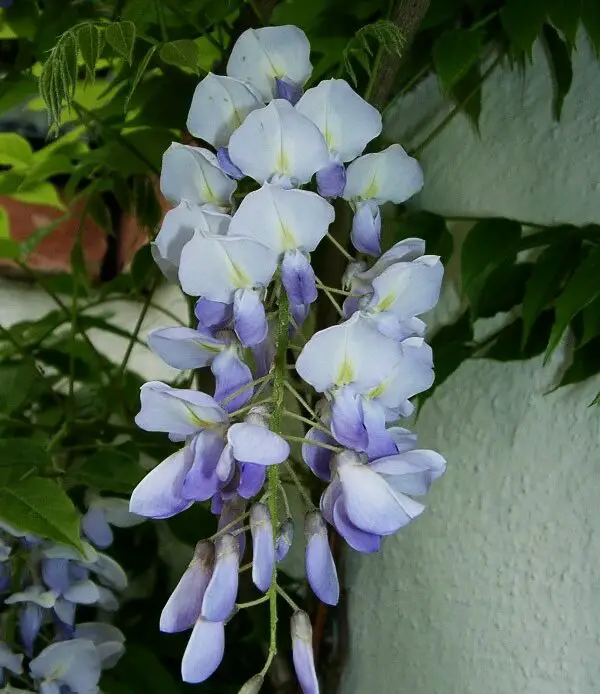
Last updated on May 22nd, 2023 at 12:21 pm
Wisteria belongs to a genus of flowering plants and is a member of the legume family known as Fabaceae. The wisteria plant consists of 10 species of vines, woody and twining, and are native to Japan, China, Vietnam, Korea, Eastern USA, and Southern Canada. The north of Iran also boasts Wisteria plants in abundance. In all these parts of the world, wisteria grows wild and free.
The plants were later introduced to Germany, France, and other European countries. Due to their beauty in terms of the colors of their flowers, and the nature of their flowing growth, they are appealing.
Wisterias are invasive plants, and they climb very fast as vines go. They can completely overrun a wall or any facade if left to grow independently without pruning. Vines are robust and as thick as your wrist. These can twine their stems across and around whatever support seems available.
The earliest known history of wisteria dates back to a botanist, Thomas Nuttall, who named the plant after an American physician, Caspar Wistar. The two were living in the city of Philadelphia at the time. This is among the stories about the origins of the name.
Another story about the name “Wisteria” comes from the Portuguese geologist and botanist Jose Francisco Correia DA Serra. He was a friend of Wistar and named the plant wisteria in honor of his friendship.
What does the Wisteria flower symbolize?
Several botanists have tried to uncover the wisteria flower meaning through the direction in which the vines grow. For instance, wisteria grows in Japan twines in a clockwise direction, and in China twines in an anti-clockwise direction. Nonetheless, botanists don’t know why this occurs other than offering a clue to the distinct kinds of wisteria.
Wisteria’s symbolism traced back to the ancient civilizations in the East is present in old Chinese and Japanese art, woodblock prints, and all other art forms, including tapestries.
Throughout centuries, wisteria and its racemes have been popularized in heraldry and family crests in Japan and China. In Japan, the famous Kabuki dance drama “Fuji Musume” (The Wisteria Maiden) is centered around a woman who embodies wisteria in spirit.
In the West, too, wisteria is included in all forms of art, such as in tiles and stained glass, and used in realism and stylistically inspired art forms.
The ancient Far Eastern cultures believe that wisteria flower symbolizes wisdom and long life, whatever the flower’s color.
All in all, the wisteria flower symbolic meanings are:
- good luck
- success
- longevity
- spirituality
- purity
- innocence
- playfulness
- adventure
Meaning of the Wisteria flower colors
Pink color

Pink wisteria, characterized by masses of hanging sprays of beautiful pink flowers with white mixed in, symbolizes an aura of youth and beauty. The shades of pink may range from a baby blush to a deeper hue.
White color

Like any white flower of beauty and grace, white wisterias represent purity and truth. This plant color can be seen in vines growing as creepers in many old churches and cathedrals in some parts of Europe. White symbolizes austerity, and you may find white wisteria hanging down from old mansions and manors of the wealthy.
Lilac & Purple color

Regarding lilac and purple wisteria, this flower means award-winning flowers. This is mainly the Japanese wisteria flower color, and with flowers having a heavenly aroma, Japanese wisteria is much sought-after. You will see flashes of pale blue and purple blooms with a little yellow in the center. This flower is symbolic of royalty, and all this plush and opulent. The blooms are cascading and full, like a full velvet elegance cover.
Interesting facts about the Wisteria flowers
- Ten identified species of the wisteria plant and flower exist, but there could be more.
- Most wisteria grown in Asia has been in existence for centuries. This has grown and developed naturally in parts of Iran, China, and Japan predominantly.
- The world’s biggest wisteria flowering plant grows in Sierra Madre, in the state of California, planted in 1894.
- Wisteria flowers grow fast. Nonetheless, if planted from a seed, flowers take decades to grow. Growth of flowers is fast if wisteria is grown from cuttings/cultivars.
- True wisteria flower meaning comes alive when the wisteria is given ample space to grow.
How to grow Wisteria flowers
Wisteria, a high-climbing, fast-growing vine with purple and blue blossoms, is a lovely addition to any garden.
- Plant the wisteria in fertile, moist, well-drained, slightly acidic soil.
- Choose a spot where they can receive at least six hours of daily sun exposure.
- Keep the soil moist in the first growing season, watering when dry.
- Use a fertilizer high in phosphorus.
How to care for Wisteria flowers
- Water the wisteria regularly and generously during their first two seasons, especially in drought or if the ground where they are planted is dry.
- Feed every spring with a general-purpose fertilizer until established, but never over-feed.
- Prune the wisteria after it blooms.
Best time to gift Wisteria flowers
Wisteria is a greedy plant as regards food and water. If you think of gifting this flower to someone, it should never be given as a potted plant.
As it needs ample space to grow and cannot rest itself on its structure, you must give this with care. You can give someone wisteria seeds, provided you are sure that the plant and its blooms will grow adequately in a place suited to it.
If you wish to give it to a friend for further growth, make sure your friend has a large garden with a wall or fence to support it.
Cuttings of the plant can be given at any time of the year, either as accents to a colorful bouquet or in a wreath. The flowers have a sweet scent but are toxic as far as some varieties go. You should check on what you are giving in advance.
Conclusion
Wisteria is graceful, lovely, and has a romantic meaning. Suggest planting as an arbor for romantic confessions or taking photos with a loved one.
Due to its longevity, a well-kept wisteria vine can produce blossoms for hundreds of spring seasons. With varieties native to Asia and North America, you can select a non-invasive vine wherever you live.
If you want to know and learn more about flowers, we at PansyMaiden can help you. Check out our fun, easy-to-read, and informative flower-related content that you will surely enjoy!
